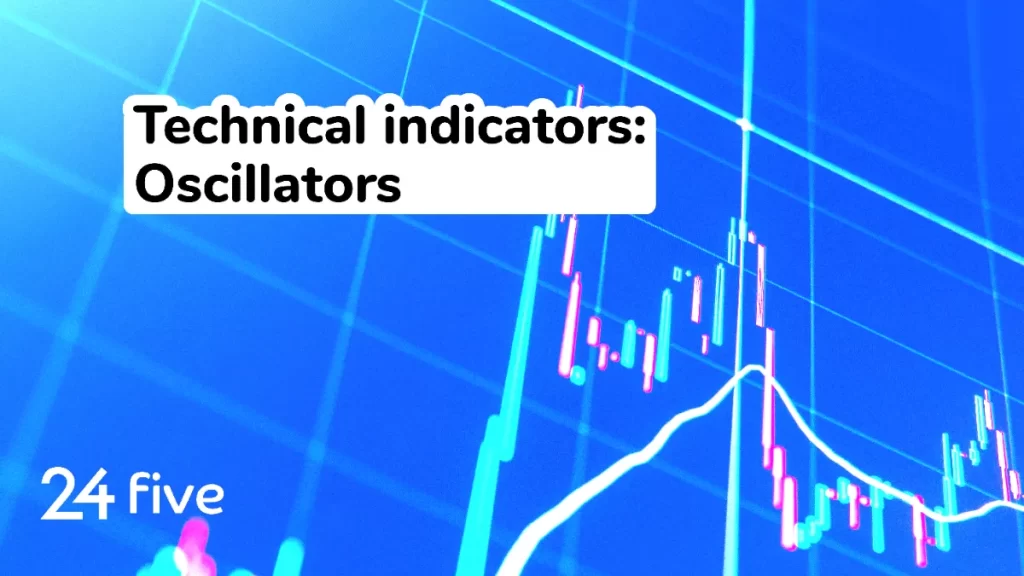Learn how to use oscillators in your trading operations. What are they and how to use them? We tell you in the following article
Definition
An oscillator in trading is a technical indicator used to analyze the price movements of a financial asset over a specific period. This indicator helps traders identify overbought or oversold conditions in the market. Oscillators are usually plotted on charts and use mathematical formulas to calculate values within a given range.

These indicators oscillate around a center line or between predefined boundaries, providing signals about the strength of price momentum and possible changes in market direction. Common examples of oscillators include the Relative Strength Index (RSI), Stochastic, MACD (Moving Average Convergence/Divergence) and the Commodity Channel Index (CCI), among others. Traders use these indicators to make buy or sell decisions, look for divergences or confirm market trends.
Why use oscillators?
Oscillators are used in trading for several reasons and in different situations:
To identify overbought and oversold conditions.
Oscillators help identify when an asset is overbought (possible time to sell) or oversold (possible time to buy). When an oscillator reaches certain extreme levels (e.g., above 70 or below 30 on the RSI), it could indicate that the asset is in an extreme condition and a change in price direction is likely to occur.
Confirming market trends
Oscillators can confirm an existing market trend. For example, if a market is in an uptrend, oscillators can show whether overbought conditions are evident and whether there could be a possible downward correction.
Identifying divergences
Divergences between price and oscillator indicators can be important signals. For example, if the price is making higher highs but the oscillator is making lower highs, it could indicate weakness in the uptrend and a possible reversal.
Generating buy or sell signals
Oscillators can generate buy or sell signals when they cross certain predefined signal levels or lines. For example, an upward crossover of the MACD above its signal line can be a buy signal, while a downward crossover could be a sell signal.
Most popular oscillators
Relative Strength Index (RSI)
The Relative Strength Index (RSI) is a technical indicator used in technical analysis to assess the strength and speed of changes in the price of a financial asset. It was developed by J. Welles Wilder and is commonly used in financial markets to identify overbought or oversold conditions.
The RSI is calculated using a formula that considers the magnitude of recent upward and downward movements in the price of an asset. The indicator ranges from 0 to 100 and is plotted in a sub-panel below the price chart.
Traditionally, an RSI above 70 is considered to indicate that an asset is overbought, which could suggest a possible downward reversal. On the other hand, an RSI below 30 indicates that an asset is oversold, which could indicate a possible reversal to the upside.
The RSI can also be used to identify divergences between price movements and the indicator itself, which is often considered a potential signal of a change in price direction.
This indicator is commonly used in technical analysis to help traders and investors make buy or sell decisions, although it is recommended to be used in conjunction with other indicators and analysis tools to get a more complete view of the market.
MACD (Moving Average Convergence Divergence)
The MACD, which stands for Moving Average Convergence Divergence, is a technical analysis indicator used to identify changes in the direction, strength and duration of a trend in a financial asset. It was developed by Gerald Appel.
The MACD is composed of three main elements:
- 1. MACD line: it is the difference between two exponential moving averages (usually the 12-period EMA minus the 26-period EMA). This line represents the convergence and divergence of these moving averages and acts as a momentum indicator.
- 2. Signal Line: It is calculated by taking an exponential moving average of the MACD line, usually of 9 periods. This line smoothes the MACD movements and is used to generate buy or sell signals.
- 3. Histogram: It is the difference between the MACD line and the signal line. Visually, it is represented as bars oscillating around a central line on the MACD chart. The histogram shows the divergence between the MACD line and the signal line.
Traders use the MACD to identify trends, inflection points and buy or sell signals. It is considered a bullish signal when the MACD line crosses above the signal line and a bearish signal when the MACD line crosses below the signal line. In addition, divergences between the MACD and the underlying price can also indicate possible changes in price direction.
Stochastic
The stochastic oscillator is a technical indicator used in financial market technical analysis to determine overbought or oversold conditions of an asset, as well as possible turning points in price direction. It was developed by George C. Lane in the 1950s.
The stochastic oscillator is based on the idea that closing prices tend to close near the highs when the market is in an uptrend, and near the lows when it is in a downtrend.
This indicator is calculated using the following formula:
%K = [(Current close – Lowest low in the %K period) / (Highest high in the %K period – Lowest low in the %K period)] x 100.
%K is the main line of the stochastic oscillator ranging from 0 to 100. Values close to 0 indicate oversold conditions, while values close to 100 indicate overbought conditions.
In addition, the stochastic oscillator also includes a secondary line called %D, which is a simple moving average of %K and is used to smooth out fluctuations in the %K line.
Traders use the stochastic oscillator to identify extreme overbought and oversold levels in an asset. Buy signals are generated when the oscillator is in the oversold zone and begins to rise, and sell signals are generated when it is in the overbought zone and begins to fall. In addition, divergences between price movements and the oscillator can also be indicative of possible changes in price direction.
Commodity Channel Index (CCI)
The Commodity Channel Index (CCI) is a technical indicator used in technical analysis to assess the strength, direction, and overbought or oversold conditions of a financial asset. It was developed by Donald Lambert in the late 1970s for use in the commodities market, although its application was later extended to other financial markets.
The CCI is calculated using the following formula:
CCI = (Typical price – Simple moving average of typical prices) / (0.015 x Standard deviation of typical prices).
The typical price is the sum of the closing price, the high price, and the low price divided by three. The simple moving average is generally calculated using 20 days, although it can be adjusted according to the trader’s preferences.
The CCI oscillates around a central line, usually located at 0, and can take both positive and negative values. Values above +100 are considered to indicate overbought conditions, while values below -100 indicate oversold conditions.
Traders use the CCI to identify extreme price levels and determine possible turning points in price direction. In addition, they look for divergences between price movements and the CCI, which could indicate possible changes in the market trend. However, it is important to remember that the CCI, like other technical indicators, is not infallible and should be used with other tools and analyses to make informed trading decisions.









